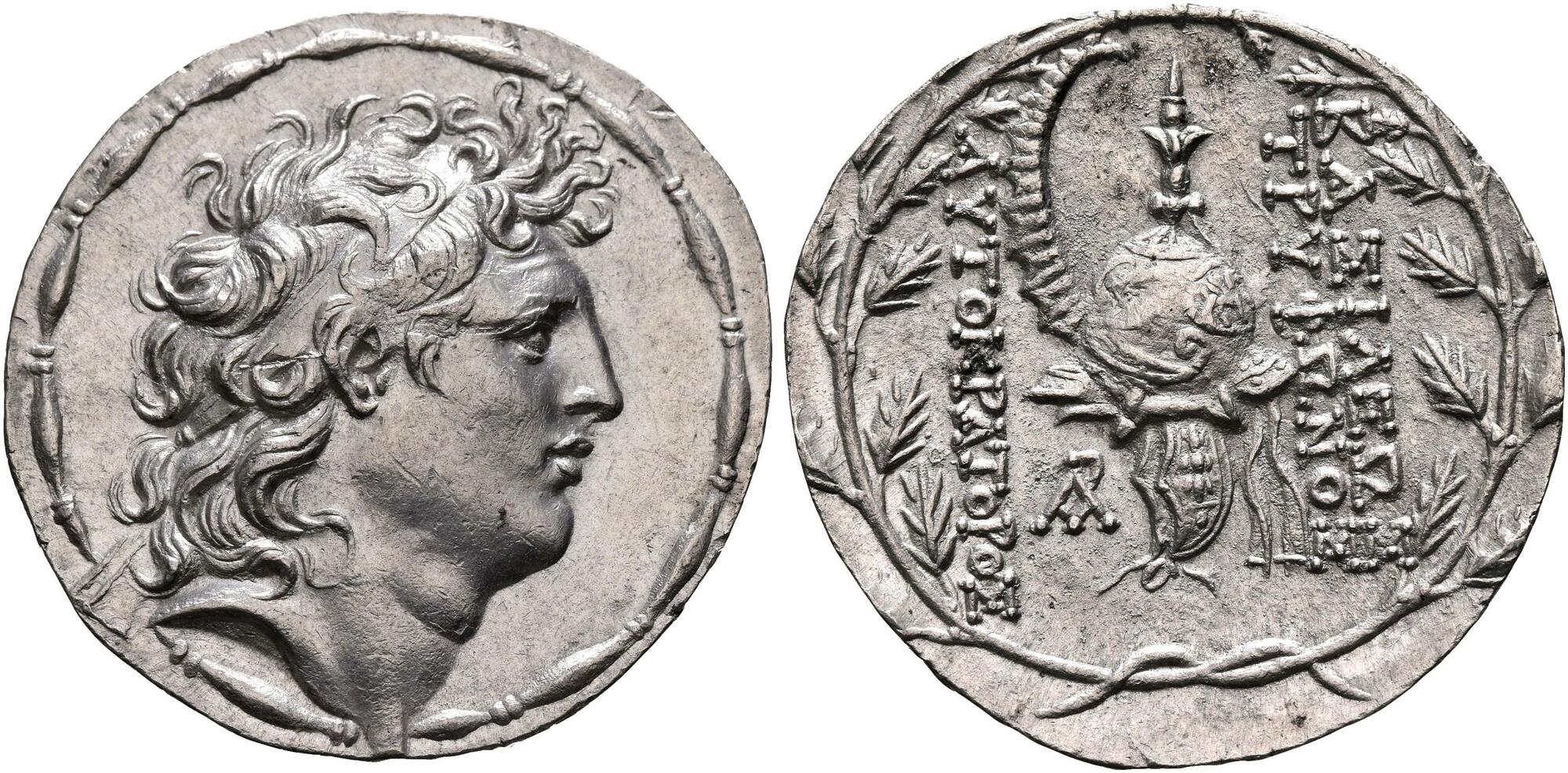Antioch (Tryphon), silver, tetradrachms (142-139 BCE)
From SILVER
142 BCE - 139 BCE Silver 9,767 kg
Description
| ObverseInscription or printing placed on the obverse.: | Diademed head of Tryphon to right |
| ReverseInscription or printing placed on the reverse.: | BAΣIΛEΩΣ / TPYΦΩNOΣ - AYTOKPATOPOΣ (Greek).Spiked Macedonian (or Cretan?) helmet with cheek guard to left, adorned with wild goat's horn above visor, in inner left field, monogram of AP, all within oak wreath |
Mint and issuing power
| MintIdentifies the place of manufacture or issue of a numismatic object.: | Antioch | Ancient regionAncient region.: | Syria | Modern countryModern country: Turkey | AuthorityIdentifies the issuing power. The authority can be "pretended" when the name or the portrait of X is on the coin but he/she was not the issuing power. It can also be "uncertain" when there is no mention of X on the coin but he/she was the issuing power according to the historical sources: | Seleucid Dynasty (312-63 BC), Tryphon (142-138 BCE) |
Chronology
| FromIdentifies the initial date in a range assigned in a numismatic context. | 142 BCE | toIdentifies the final date in a range assigned in a numismatic context.. | 139 BCE | PeriodTime period of the numismatic object.: Hellenistic 323-30 BC |
Physical description
| MetalThe physical material (usually metal) from which an object is made.: | Silver |
Median weightMedian of the weights of numismatic objects (in grams). in grams | 16.60 | DenominationTerm indicating the value of a numismatic object. Examples: tetradrachm, chalkous, denarius.: | tetradrachm |
StandardStandard.: | Attic |
Image

S2034 Antioch Tryphon.jpg [1]
References
| Die study referencePublication of the study: | Houghton 19911Houghton 1991, p. 92-93 (Table 6) | ||
| Coin series referenceReference to coin series study: | Sear II2Sear II, n° 7085, SC II3SC II, n° 2031, HGC 94HGC 9, n° 1055 | ||
Obverse dies distribution
| FrequencyFrequency of specimen in distribution. ᵖ | Number of obversesNumber of obverse dies. ᵖ (o) | % (o) | Number of coinsNumber of coins. (n) | % (n) | Die nameName(s) of the die(s). |
| 1 | 9 | 42.86 | 9 | 17.31 | 3, 6, 9, 10, 11, 13, 17, 18, 19 |
| 2 | 7 | 33.33 | 14 | 26.92 | 1, 2, 5, 7, 8, 12, 14 |
| 3 | 2 | 9.52 | 6 | 11.54 | 4, 16 |
| 5 | 1 | 4.76 | 5 | 9.62 | 20 |
| 6 | 1 | 4.76 | 6 | 11.54 | 15 |
| 12 | 1 | 4.76 | 12 | 23.08 | 21 |
| Total | 21 of 21 | 99.99 | 52 of 52 | 100.01 |
Reverse dies distribution
no distribution is available
Quantification
| Number of obversesNumber of obverse dies. ᵖ (o) | 21 | Number of singletons (o1)The number of singleton coins. ᵖ | 9 |
| Number of reverse diesNumber of reverse dies. (r) | Number of coinsNumber of coins. (n) | 52 | |
| Coins per obverse dieNumber of coins per obverse die. (n/o) | 2.48 | Coins per reverse dieNumber of coins per reverse die. (n/r) | |
| Reverse per obverse ratioRatio of obverse dies divided by reverse dies. (r/o) | Percentage of singletons (o1)number of coins (n) divided by the number of singletons (o1) ᵖ | 42.86 % | |
| Original number of dies (O) (Carter 1983 formula)The estimation of the number of coins according to Carter 1983 ᵖ | 29.42 | Coins struck if 20,000 as average productivity per dieCoins made if the average productivity for obverses (according to Carter) is 20,000. ᵖ | 588,400 |
| Original number of dies (O) (Esty 2011 formula)The estimation of the number of coins according to the singleton formula in Esty 2011 ᵖ (O) | 35.23 | Survival rate if 20,000 as average productivity per dieSurvival rate if average productivity is 20,000. ᵖ | 0.00009 |
| Coverage (o = % of O) (Esty 1984 formula)Esty 1984 - coverage (% of O) ᵖ (o = % of O) | 82.69% | Die productivity if survival rate 1/2,000Average productivity if survival rate is 1/2,000. ᵖ | 3,535.01 |
| Weight of silver (in kg) if 20,000 coins per die (O = Carter formula)Carter 1983 * Median weight * 20000 (*10 if gold or electrum) ᵖ | 9,767 kg <br /> 9,767 kg | Die productivity if survival rate 1/5,000Average productivity if survival rate is 1/5,000. ᵖ | 8,837.53 |
Remarks
References
- ^ Houghton, Arthur (1991), "The Antioch Project," in William E. Metcalf (ed.), Mnemata : papers in memory of Nancy M. Waggoner, New York, p. 73-97
- ^ Sear, David R. (1979), Greek coins and their values. Vol. II, Asia and North Africa, London, xlviii, p. 317-762
- ^ Houghton, Arthur - Lorber, Catharine C. - Hoover, Oliver D. (2008), Seleucid coins : a comprehensive catalogue. Part 2, Seleucus IV through Antiochus XIII, 2 v., New York - Lancaster - London, (xxx), 120 p. of plates : ill., maps, tables
- ^ Hoover, Oliver D. (2009), Handbook of ancient Syrian coins : royal and civic issues, fourth to first centuries BC, The Handbook of Greek Coinage 9, Lancaster, lxix, 332 p.